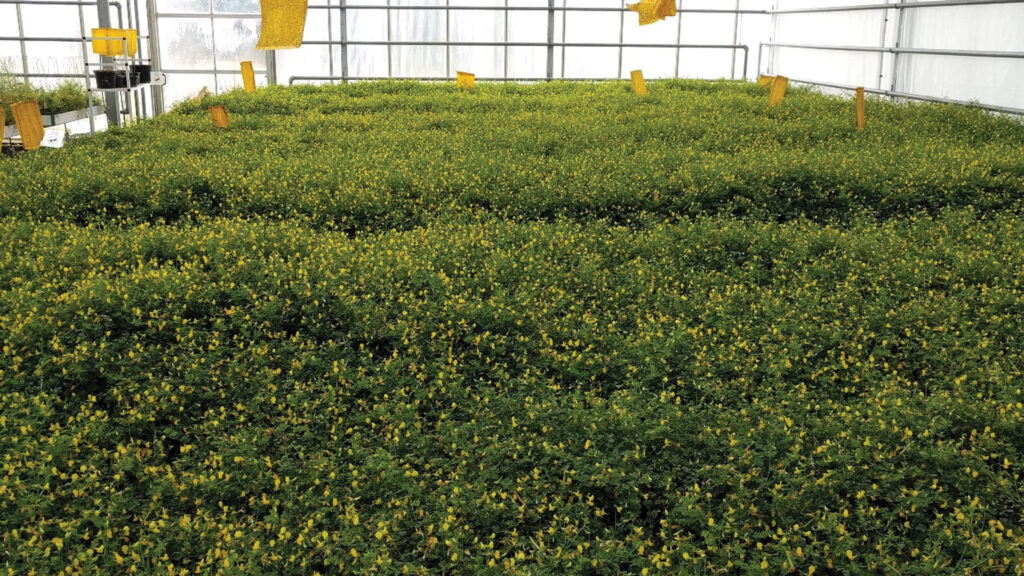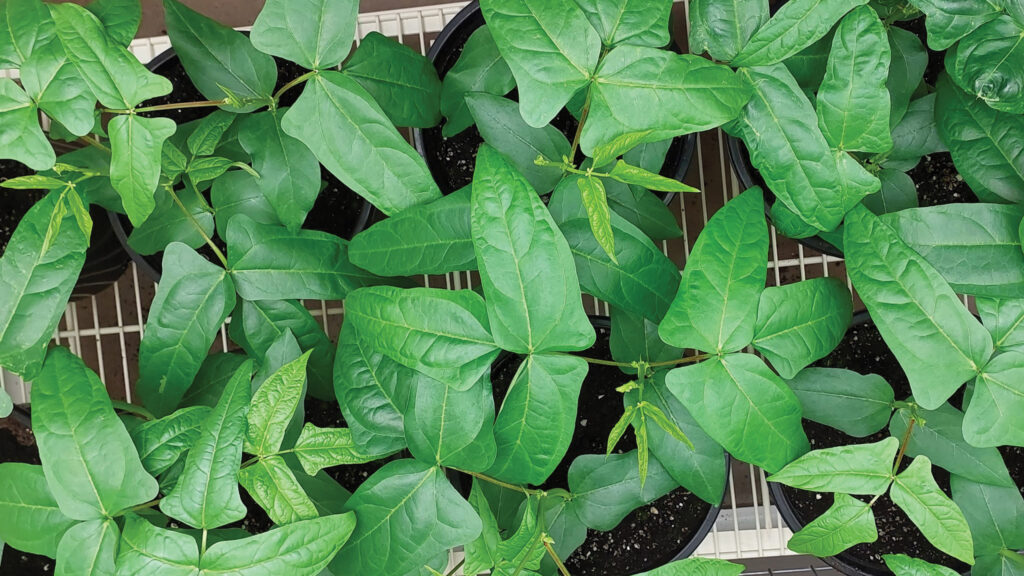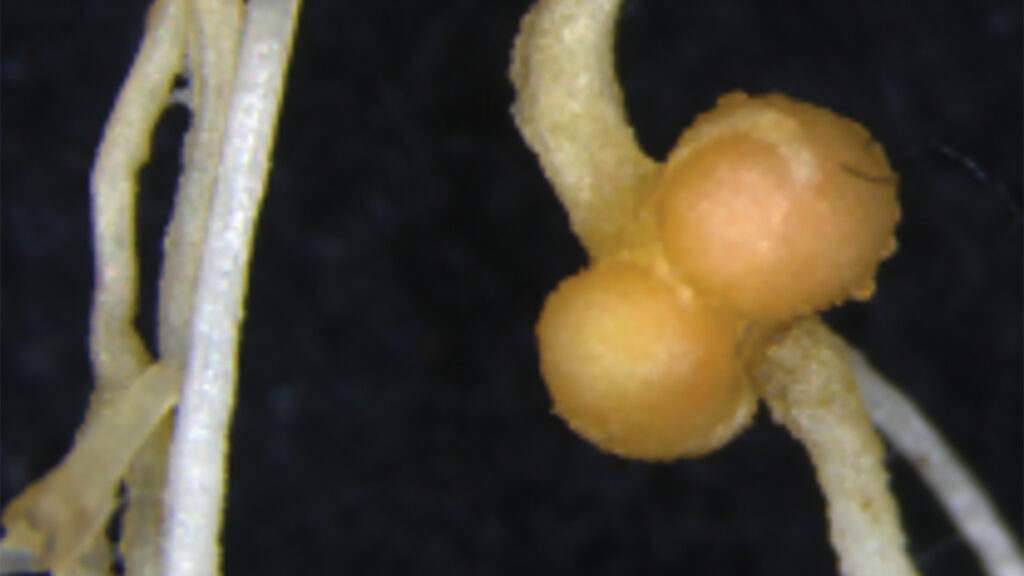Genetic ‘off switch’ and zinc discovery could promote N fixation
 © Ensa
© Ensa A genetic “off switch” that shuts down nitrogen fixation when soil nitrate levels are high has been identified by a global group of scientists.
The regulator gene was successfully removed, to enable model legumes to continue fixing nitrogen regardless of the soil environment.
Researchers say these results, which were carried out as part of the international Enabling nutrient symbioses in agriculture project (Ensa) could be key to understanding how to increase legume fixing capacity.
See also: How natural fungi can be encouraged to aid crop production
The effect of zinc
The team discovered the “genetic off-switch” known as the “fixation under nitrate” (FUN) regulator after screening 150,000 individual legume plants in which genes were knocked out to identify how plants control the switch from nitrogen fixation to soil nitrogen uptake.
This led to the secondary discovery that the micronutrient zinc plays an important role in triggering the regulator to become active, which consequently shuts down nitrogen fixation.
Dr Kasper Andersen, co-author and Ensa researcher, explains how the team found changing soil nitrogen levels to alter the levels of zinc in the plant.
“Zinc had not previously been linked to the regulation of nitrogen fixation, but our study found that a change in zinc levels in turn activates FUN.
This then controls a large number of genes that shut down nitrogen fixation,” he says.
Legumes like beans, peas and lentils are unique among crops for their ability to interact with soil bacteria to fix nitrogen from the air and convert this into a plant available form of nutrients.
However, this biological process is often reduced when nitrogen is already abundant in the soil, either through natural processes or through the application of synthetic fertiliser.
“From an agricultural perspective, continued nitrogen fixation could be a beneficial trait that increases nitrogen availability, both for the legume and for future crops that rely on the nitrogen left behind in the soil after legumes are grown,” explains Dr Dugald Reid, lead author and researcher with Ensa.
“This helps lay the foundations for future research that provides new ways for us to manage our farming systems to reduce nitrogen fertiliser use and increase farm incomes,” says Dugald.
The FUN regulator is a type of gene known as a transcription factor which controls the levels of other genes.
It was found to be present in legumes regardless of whether it was active or inactive, and irrespective of nitrogen levels.

© ENSA
Screening legumes
Dr Jieshun Lin, co-author of the paper and Ensa researcher, explains how a genetic screen for thousands of plants in greenhouses was designed to identify genes that connect environmental triggers with biological signals.
“By increasing the nitrate levels available to the model legume, we were able to identify those with impaired nitrogen fixing regulation, and uncover the fixation under nitrate mutant.
Removing FUN, therefore, creates a condition in which nitrogen fixation is no longer shut down by the plant,” he says.
The team then used a combination of biochemistry, gene expression studies and microscopy to find that the genetic regulator forms long protein filaments when it is inactive.
This led to the discovery that zinc mediates control of nitrogen fixation via transcription factor filamentation.
The research report goes on to explain how plants adapt to fluctuating environmental conditions by adjusting their metabolism and gene expression.
In legumes, nitrogen homeostasis is maintained by balancing nitrogen acquired from soil resources with nitrogen fixation by symbiotic bacteria in root nodules.
“We show that zinc, an essential plant micronutrient, acts as an intracellular second messenger that connects environmental changes to transcription factor control of metabolic activity in root nodules.”
The FUN regulator essentially acts as a sensor, with the zinc controlling “the transition between an inactive filamentous megastructure and an active transcriptional regulator”.
Lower zinc concentrations in the nodule, which occur in response to higher levels of soil nitrate, dissociates the filament and activates FUN.
FUN then directly targets multiple pathways to initiate breakdown of the nodule.
“The zinc-dependent filamentation mechanism thus establishes a concentration readout to adapt nodule function to the environmental nitrogen conditions,” states the research paper.
“These results have implications for understanding the roles of metal ions in integration of environmental signals with plant development and optimising delivery of fixed nitrogen in legume crops,” it continues.
The study was led by scientists from La Trobe University, Australia and Aarhus University, Denmark, and involved collaborations with the European Synchrotron Radiation Facility (ESRF), Centro de Biotecnología y Genómica de Plantas, Spain and Universidad Politécnica de Madrid (UPM).
The researchers are now investigating how common legume crops such as soybean and cowpea perform when they lose FUN activity.
What is the Enabling Nutrient Symbioses in Agriculture project?

© Ensa
Enabling Nutrient Symbioses in Agriculture (Ensa) is an international research project aimed at enhancing biological nitrogen fixation to increase yields.
Ultimately, the project hopes to reduce input costs and lower environmental impact, while also making farming more viable in areas of degraded land, as well as exploring the possibility of replicating this mechanism in cereal crops.
The project is pursuing several lines of inquiry, which include studying legumes, which already interact with soil bacteria to source nitrogen, so that this ability can be further enhanced.
The project also hopes to invest in breakthrough agricultural research to meet the needs of smallholder farmers in sub-Saharan Africa and South Asia.
Established in 2012, Ensa connects researchers from leading institutions and universities across Europe, including the UK, Netherlands, Germany, Denmark and France.
It is a partnership between the University of Cambridge Crop Science Centre, Aarhus University, University of Oxford, Albert-Ludwigs-Universität Freiburg, Niab, University Toulouse, University of Illinois, and Wageningen University.
The Ensa project is receiving grant funding from Bill & Melinda Gates Agricultural Innovations and has previously been supported (2012-2024) through grants from the Bill and Melinda Gates Foundation and the UK government’s Foreign, Commonwealth and Development Office.
Source: Ensa
Essential plant structure discovered for root nodule symbiosis
A new research paper published by the Ensa team outlines the discovery of a critical structure in plant receptors that plays an essential role in root nodule symbiosis and signalling.
This is the process in which plants are able to form mutually beneficial relationships with nitrogen-fixing bacteria.
The structural feature known as the juxtamembrane motif acts as a “molecular Velcro” and helps connect the proteins in the signalling pathway in nitrogen-fixing symbiosis.
Further investigations revealed that the juxtamembrane motif is conserved across various plant species, suggesting that it plays a broader role in plant-microbe interactions beyond legumes.
The paper states: “Understanding the molecular mechanisms that enable nitrogen-fixing symbiosis is crucial for ongoing efforts to engineer this trait into non-legume crops.”

